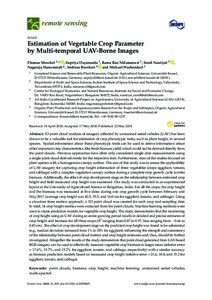| dcterms.abstract | 3D point cloud analysis of imagery collected by unmanned aerial vehicles (UAV) has been shown to be a valuable tool for estimation of crop phenotypic traits, such as plant height, in several species. Spatial information about these phenotypic traits can be used to derive information about other important crop characteristics, like fresh biomass yield, which could not be derived directly from the point clouds. Previous approaches have often only considered single date measurements using a single point cloud derived metric for the respective trait. Furthermore, most of the studies focused on plant species with a homogenous canopy surface. The aim of this study was to assess the applicability of UAV imagery for capturing crop height information of three vegetables (crops eggplant, tomato, and cabbage) with a complex vegetation canopy surface during a complete crop growth cycle to infer biomass. Additionally, the effect of crop development stage on the relationship between estimated crop height and field measured crop height was examined. Our study was conducted in an experimental layout at the University of Agricultural Science in Bengaluru, India. For all the crops, the crop height and the biomass was measured at five dates during one crop growth cycle between February and May 2017 (average crop height was 42.5, 35.5, and 16.0 cm for eggplant, tomato, and cabbage). Using a structure from motion approach, a 3D point cloud was created for each crop and sampling date. In total, 14 crop height metrics were extracted from the point clouds. Machine learning methods were used to create prediction models for vegetable crop height. The study demonstrates that the monitoring of crop height using an UAV during an entire growing period results in detailed and precise estimates of crop height and biomass for all three crops (R2 ranging from 0.87 to 0.97, bias ranging from −0.66 to 0.45 cm). The effect of crop development stage on the predicted crop height was found to be substantial (e.g., median deviation increased from 1% to 20% for eggplant) influencing the strength and consistency of the relationship between point cloud metrics and crop height estimates and, thus, should be further investigated. Altogether the results of the study demonstrate that point cloud generated from UAV-based RGB imagery can be used to effectively measure vegetable crop biomass in larger areas (relative error = 17.6%, 19.7%, and 15.2% for eggplant, tomato, and cabbage, respectively) with a similar accuracy as biomass prediction models based on measured crop height (relative error = 21.6, 18.8, and 15.2 for eggplant, tomato, and cabbage). | eng |

